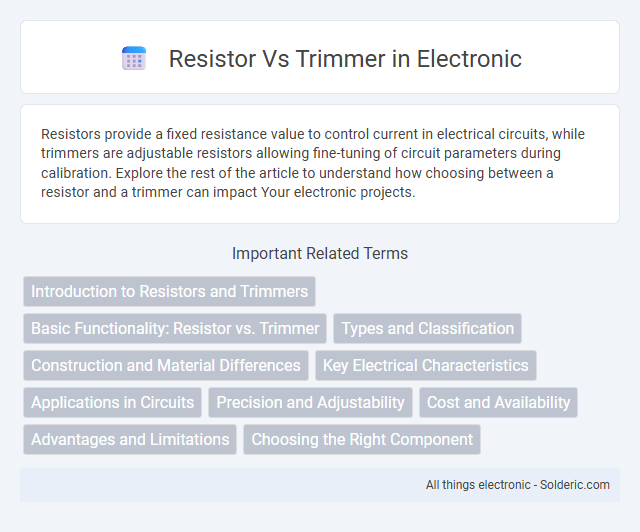Resistors provide a fixed resistance value to control current in electrical circuits, while trimmers are adjustable resistors allowing fine-tuning of circuit parameters during calibration. Explore the rest of the article to understand how choosing between a resistor and a trimmer can impact Your electronic projects.
Comparison Table
| Feature | Resistor | Trimmer |
|---|---|---|
| Definition | Fixed electrical component limiting current. | Adjustable resistor for fine-tuning circuits. |
| Adjustability | Fixed resistance value. | Variable resistance, manually adjustable. |
| Use Case | Stable resistance in circuits. | Calibration and tuning applications. |
| Range | Specified fixed ohm value. | Adjustable within a set ohm range. |
| Size | Typically smaller and simpler. | Generally larger due to adjustment mechanism. |
| Cost | Lower cost. | Higher cost due to complexity. |
| Durability | More durable with no moving parts. | Less durable; adjustment mechanism wears out. |
Introduction to Resistors and Trimmers
Resistors are fixed electronic components used to control current flow and voltage levels in circuits by providing a specific resistance value. Trimmers, also known as adjustable resistors or potentiometers, allow precise resistance adjustments to fine-tune circuit performance during calibration. Understanding the difference between fixed resistors and trimmers helps you select the right component for stable or variable resistance needs in electronic designs.
Basic Functionality: Resistor vs. Trimmer
A resistor provides a fixed resistance value to control current flow in electronic circuits, ensuring stable voltage and current levels. A trimmer, or trimmer resistor, offers adjustable resistance, allowing fine-tuning of circuit parameters during calibration or setup. Resistors are typically used for consistent, unchanging resistance, while trimmers enable dynamic adjustments for precise control.
Types and Classification
Resistors are passive electrical components categorized into fixed types such as carbon film, metal oxide, and wire-wound, and variable types like potentiometers and rheostats; trimmers are specialized variable resistors designed primarily for fine-tuning circuit parameters, typically available as trimmer potentiometers and trimmer capacitors. Fixed resistors are classified by resistance value, tolerance, power rating, and construction materials, whereas trimmers are classified based on adjustment method (screw or slider), resistance range, and stability for calibration purposes. The selection between resistors and trimmers depends on their classification, with resistors providing stable resistance and trimmers offering precise adjustment within circuits.
Construction and Material Differences
Resistors are typically constructed using a resistive element such as carbon film, metal oxide, or wire wound around an insulating core, designed for fixed resistance values. Trimmers, on the other hand, feature an adjustable resistive path often made from similar materials but integrated with a movable contact or wiper mechanism for fine-tuning electrical characteristics. Your choice between a resistor and a trimmer hinges on whether you need stability with fixed resistance or flexibility with adjustable resistance during circuit calibration.
Key Electrical Characteristics
Resistors provide a fixed resistance value with high stability and low tolerance, essential for consistent voltage and current control in circuits. Trimmers offer adjustable resistance, allowing you to fine-tune circuit performance with precision during calibration or maintenance. Key electrical characteristics include power rating, tolerance, temperature coefficient, and adjustability, where resistors excel in stability and trimmers in flexibility.
Applications in Circuits
Resistors are essential components in electronic circuits, primarily used for current limiting, voltage division, and signal conditioning due to their fixed resistance values. Trimmer resistors, or trimmers, allow precise adjustment of resistance during calibration, enabling fine-tuning in applications such as sensor calibration, oscillator frequency setting, and offset adjustment in amplifiers. Their adjustability makes trimmers ideal for circuits requiring periodic calibration or optimization, whereas standard resistors are preferred for stable, fixed-resistance applications.
Precision and Adjustability
Resistors provide fixed resistance values with high precision and stability, making them ideal for circuits requiring consistent performance. Trimmers, also known as variable resistors, offer adjustable resistance, allowing fine-tuning and calibration within a circuit for optimal operation. The choice between a resistor and a trimmer depends on whether fixed accuracy or flexible adjustment is needed in the application.
Cost and Availability
Resistors, being standard components, are widely available and cost-effective, making them ideal for mass production and general electronic applications. Trimmers, which are adjustable resistors, tend to be more expensive and less commonly stocked, as they serve specialized calibration or tuning purposes. When balancing budget and accessibility for your project, fixed resistors typically offer greater affordability and ease of procurement compared to trimmers.
Advantages and Limitations
Resistors provide stable and fixed resistance with high precision and reliability, making them ideal for consistent voltage and current control in electronic circuits. Trimmers, or variable resistors, allow fine-tuning of resistance values during calibration or adjustment, offering flexibility but may suffer from lower stability and potential drift over time. Resistors excel in durability and cost-effectiveness for permanent settings, while trimmers are better suited for applications requiring customization and periodic resistance adjustments.
Choosing the Right Component
Choosing the right component between a resistor and a trimmer depends on the application and precision required. Fixed resistors provide a stable, predefined resistance ideal for consistent circuit performance, while trimmers offer adjustable resistance for fine-tuning and calibration. Your selection should consider whether you need permanent resistance values or the flexibility to modify settings during operation.
resistor vs trimmer Infographic

 solderic.com
solderic.com